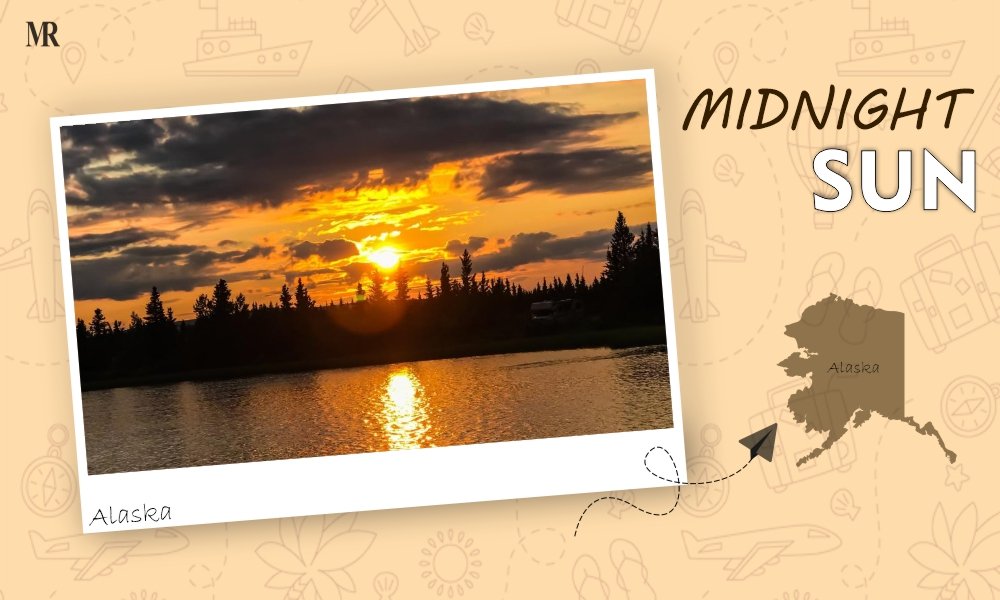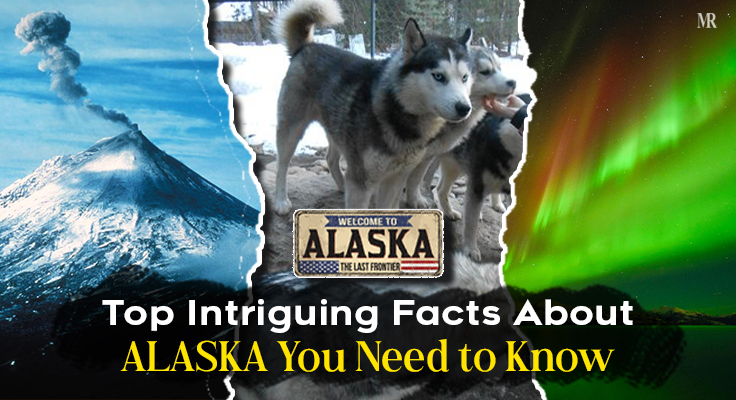Have you ever dreamt of witnessing a dazzling light show dancing across the night sky? Or experiencing the surreal sensation of a sun that never sets? Perhaps exploring a land shaped by volcanoes and glaciers sparks your sense of adventure. If so, then these facts about Alaska will provide you with its unique natural phenomena.
Interestingly, Alaska is regarded as America’s last great frontier. For good reason- it has a wealth of wildlife, rich natural resources, and varied scenery. Are you curious as to why you ought to visit this location? These ten fascinating facts about Alaska will inspire you to start packing.
In this blog, we’ll explore facts about Alaska and why it should be your next travel destination. So, let’s begin!
1. Alaska was once sold worth $7.2 million
Alaska, a land of rugged beauty and vast wilderness, has a fascinating history. Before it became a US territory, it was part of the Russian Empire. In 1741, Vitus Bering led a Russian expedition that explored the region. Fast forward to March 30, 1867, when the United States purchased Alaska from Russia for a mere $7.2 million.
William H. Seward, the US Secretary of State, negotiated the deal, while Edouard de Stoeckl represented Russia. Critics initially ridiculed the purchase as “Seward’s Folly” or “Seward’s Icebox.” However, Alaska’s value soared, estimated at an impressive $129 million today.
As of May 2024, Alaska Air has a $5.42 billion net value. Serving cities all over North America, the group works with partner regional carriers. The carrier’s primary fleet consists of Airbus A320 family jets and B737 jets. Thus, it’s one of the facts about Alaska.
2. Pavlof Volcano

Alaska is known as “the land of volcanoes.” because of the frequency of explosions. Consequently, it makes one of the facts about Alaska. It also has over 130 volcanoes and 90 are believed to be active. With a height of almost 8,260 feet (2,518 meters), Pavlof stands as one of Alaska’s tallest volcanoes.
Besides that, after the late 1700s, Pavlof volcano has erupted 40 times. Geologists refer to it as a “wet” volcano, due to the snow and ice that cover its summit.
Moreover, the Pavlof Volcano is no longer erupting. Since December 11, 2022, the seismicity has dropped to background levels and no explosions have been detected.
3. Northern Lights
The Northern Lights, also known as the Aurora Borealis. While it may be seen in other parts of the world, Alaska provides a singularly breathtaking viewing experience. Alaska’s winter nights offer extended periods of darkness, creating the perfect chance for the aurora to shine.
Consider these Southcentral Alaska basecamps for northern lights viewing: Talkeetna, Anchorage, and the Mat-Su Valley. Visitors can also view it from all over the Alaska states. However, the chances of seeing them decrease as you head south.
Besides that, visitors can take a guide who will demonstrate the facts about Alaska. They generally explain the physics of its natural occurrence and more.
4. Boreal Forest

The boreal forest, also known as taiga, stretches across Alaska and much of the northern hemisphere. It is the biggest wooded biome on Earth, which makes up around one-third of the planet’s total forest area. It also spans 17 million km in the Northern Hemisphere.
Besides that, it stretches across the interior between mountain ranges, blanketing a massive area. This sheer size provides a habitat for a wealth of wildlife, including moose, bears, caribou, and numerous bird species.
In addition, Boreal forest covers about 60–70% of Alaska’s land area. Whereas the remaining areas are covered by tundra and coastal coniferous forest. As such, the Boreal Forest is one of the facts about Alaska
5. Bering Glacier
The Bering Glacier is an astounding 2,030 square kilometers or nearly 1,900 square miles in size. It occupies this area along with its feeding grounds on the Bagley Icefield. The general tourist season in Alaska is from May to September. This is when you’ll have the warmest weather and the most daylight hours for sightseeing.
Matanuska Glacier is the largest and easiest glacier to reach by car in Alaska. Situated around two hours north of Anchorage, this well-liked structure spans 27 miles in length and 4 miles in width. It provides numerous guided tour opportunities, with equipment provided.
Moreover, the Bering Glacier, among the facts about Alaska plays a significant role in Alaska’s environment. It stores vast amounts of freshwater, regulates sea levels, and influences weather patterns.
6. Brooks Range

In honor of renowned Alaskan geologist Alfred Brooks, the Brooks Range was given its name. Clocking in at 700 miles long, the Brooks Range mountains form a mighty backbone. They slice through Alaska’s central Arctic, extending into Canada’s Yukon Territory.
Moreover, visitors can glimpse the Brooks Range along the rocky Dalton Highway, which stretches north of Fairbanks to Prudhoe Bay/Deadhorse. Furthermore, it passes through the mountain range along Atigun Pass at 4,739 feet in height. The majority of this remote area is only accessible by air taxi.
The Brooks Range offers a bounty of outdoor activities for visitors. They can enjoy hiking, fishing, canoeing, animal observation, and more. Besides that, it is also home to Dall sheep, wolves, martens, caribou, fox, and lynx.
7. Oil Pipeline
TAPS, a vital pipeline for Alaska’s future, celebrated 47 years of operation in 2024. It transports 3.86 percent of the country’s oil production and is a testament to the state’s pioneering spirit.
Moreover, Alaska’s 800-mile pipeline stretches from Prudhoe Bay to Valdez. Also, the Valdez Marine Terminal loads oil that is shipped to markets worldwide.
Above all, the Trans-Alaska Pipeline holds the key to transporting Alaska’s North Slope oil. It’s the only practical way to get crude oil from Prudhoe Bay down to Valdez. Furthermore, 13% of the country’s domestic oil production is transported by it.
8. Midnight Sun

Alaska is famous for its stunning natural beauty. One of the most unique phenomena you can experience is the midnight sun. It occurs during the summer months, from late May to early August when the sun stays above the horizon for 24 hours a day.
Moreover, the interesting fact about the midnight sun is Earth’s tilt on its axis and its path around the sun. This phenomenon creates long stretches of daylight in Alaska during the summer months. During the summer, the tilt of the Earth positions the Arctic Circle, including northern Alaska, facing the sun.
Above all, it creates a truly magical experience. Alaska’s long summer days offer extended daylight hours. This allows visitors plenty of time to enjoy outdoor activities like hiking, biking, fishing, and kayaking. Also, many communities hold traditional festivals and gatherings during the midnight sun season.
9. More than 3 million natural lakes in Alaska
Alaska boasts the most lakes in North America by a wide margin. With an estimated 3 million lakes bigger than 5 acres, the state offers an abundance of freshwater environments. However, Alaska’s lakes are a diverse bunch. Some boast crystal-clear turquoise waters, while others hold a deep, mysterious blue.
Besides that, Alaska’s lakes are teeming with life. They provide vital habitat for a variety of fish species, including salmon, trout, and pike. These lakes also attract diverse bird populations, from majestic bald eagles to playful loons. So, that’s one of the facts about Alaska.
Lastly, Alaska is a wonderful location for outdoor lovers because of its vast lake system. Its lakes cater to all interests. Kayak on a crystal-clear mountain lake, battle for a trophy fish, or relax at a campground and gaze at the stars – the choice is yours.
10. Alaskan Malamute

The Alaskan Malamute, a majestic and powerful dog breed, embodies the spirit of Alaska’s rugged wilderness. The Malamutes are one of the oldest sled dog breeds with a history tracing back thousands of years. Besides that, they valued these dogs for their strength, endurance, and loyalty.
Indigenous Inuits of Alaska’s northwest named the Malamute breed in honor of their tribe. Despite their massive stature, Malamutes are known for their amiable and kind dispositions. Moreover, to ensure a well-mannered and happy Malamute, socialization and training are necessary.
In addition, Malamute weighs between 75 and 85 pounds and has a shoulder height of 23 to 25 inches. Typically, the cost of an Alaskan Malamute puppy is in the range of $1500 to $3000 which makes it one of the facts about Alaska.
Final thoughts
In conclusion, we explored 10 facts about Alaska and discovered its diverse wonders leaving us in awe. Moreover, we have also journeyed through time, witnessing the legacy of the Alaskan Malamute and the marvel of human ingenuity.
Above all, whatever your adventure spirit craves, Alaska awaits. Pack your bags, embrace the free beauty, and discover why Alaska is truly the Last Frontier. Are you ready to experience the magic for yourself? Fingers crossed for your next adventure. Thanks for reading!











